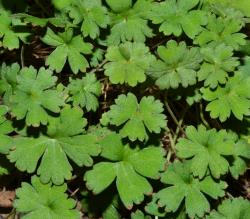- Taxon
- Gallery
- = Geranium microphyllum var. discolor G.Simpson & J.S.Thomson, Trans. & Proc. Roy. Soc. New Zealand 73: 156 (1943)
- = Geranium microphyllum var. obtusatum G.Simpson & J.S.Thomson, Trans. & Proc. Roy. Soc. New Zealand 73: 156 (1943)
Perennial herb, often with thick or fairly thick caulorrhiza. Hairs soft, retrorse or antrorse, usually appressed and often short, rarely spreading. Stems slender, prostrate, sometimes spreading to suberect, usually with retrorse hairs, sometimes glabrescent at base; branches few to many. Basal lvs not generally persistent through growing season; petioles to c. 17 cm long; hairs retrorse, dense or moderately dense, occasionally scattered. Lamina to 4 cm diam., reniform to orbicular or broadly ovate, lobed to c. ⅞ way to midrib, sometimes shallowly lobed; lobes usually 3–5, narrowly to broadly obovate-cuneate or almost oblong, with few to many appressed hairs on both sides, rounded to acute or mucronate at apex; larger lobes usually with 2 ± oblong secondary lobes. Cauline lvs smaller, with fewer lobes. Peduncles (with pedicels) 1–6–(9) cm long, filiform, with dense, retrorse hairs; bracteoles linear to lanceolate; fls 1–(2). Sepals 3–5–(6) × 0.8–2–(2.5) mm, ± lanceolate to elliptic or elliptic-oblong, usually with a purple marginal line, sometimes completely purple; hairs usually appressed, at least in distal 1/2, sometimes long and glandular, occasionally few. Petals (4)–6–9 × 2.5–4.5 mm, broadly obovate, white. Mericarps 2–2.8 mm long, with moderately dense hairs; beak (6)–7–11 mm long. Seed 1.5–1.9 mm long, oblong, ± smooth, very rarely finely reticulate.
[From: Webb et al. (1988) Flora of New Zealand. Volume 4.]
Flowering: Oct.–Feb.




